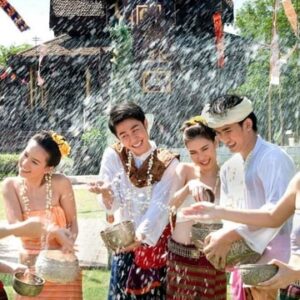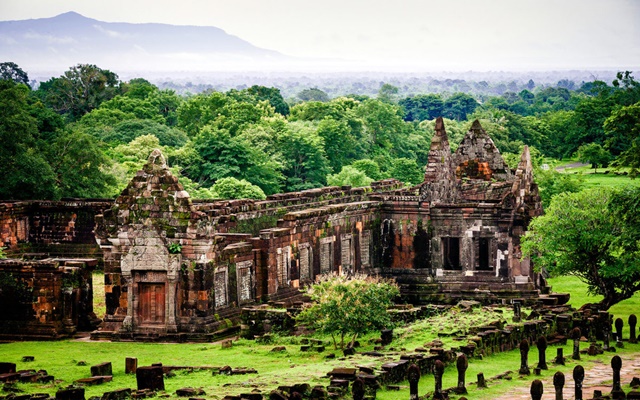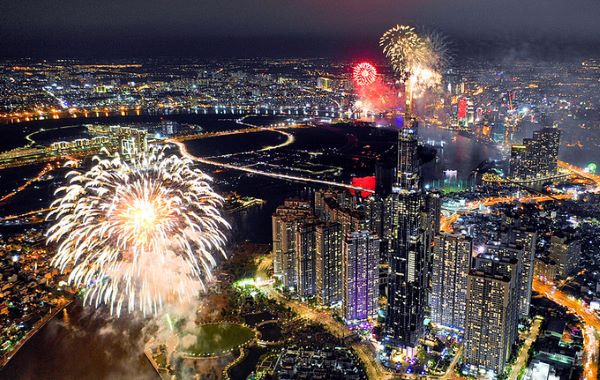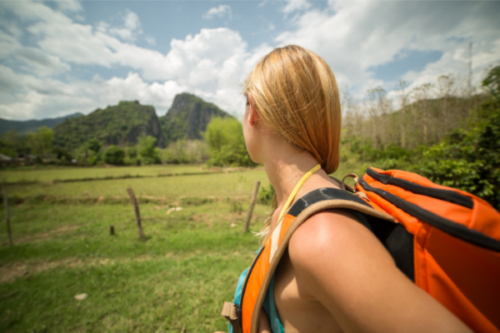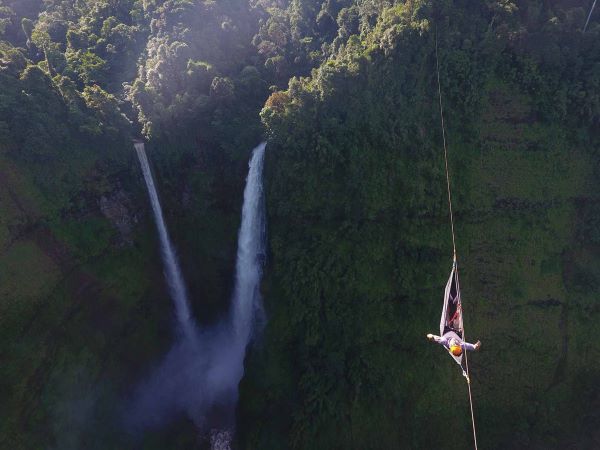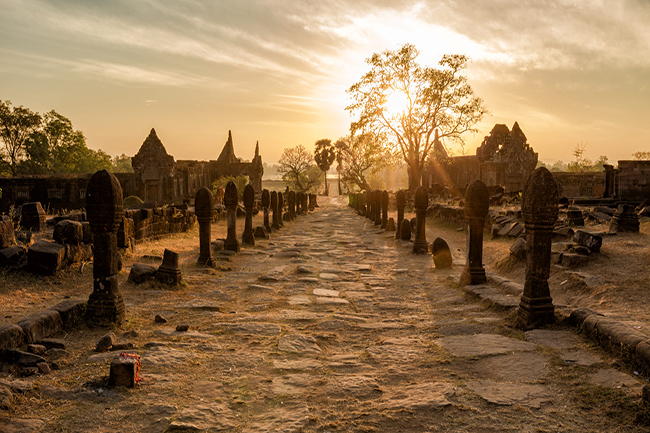Can you believe we can celebrate the New Year festival in the middle of the year? It is not uncommon to visit Laos in April – an unforgettable way by immersing yourself in the lively and festive tradition of Laos. As the world prepares to welcome the year 2025, Laos shines with contagious energy and overflowing joy with the celebration of the Water Festival, Boun Pi Mai.
This unique and culturally rich experience offers visitors an unparalleled opportunity to discover Laotian culture and participate in ancestral rituals imbued with meaning and spirituality.
Travel guide to the New Year in Laos 2025 : Immerse yourself in the Boun Pi Mai Water Festival
What is Boun Pi Mai?
The New Year in Laos, known locally as Boun Pi Mai or Pi Mai, marks an annual traditional festival occurring in the heart of April. Guided by the Buddhist calendar, Laos inaugurates the arrival of its new year when the Sun enters the sign of Aries, thus illuminating the forthcoming festivities.
During this celebration, the streets resonate with laughter and splashes of water, while prayers for luck and peace echo in the air, offering a promising start to the year ahead.
Similar to its neighboring countries: Songkran – Thailand and Chol Chnam Thmay – Cambodia, Boun Pi Mai in Laos embodies essential values such as freshness, prosperity, happiness, and purity.
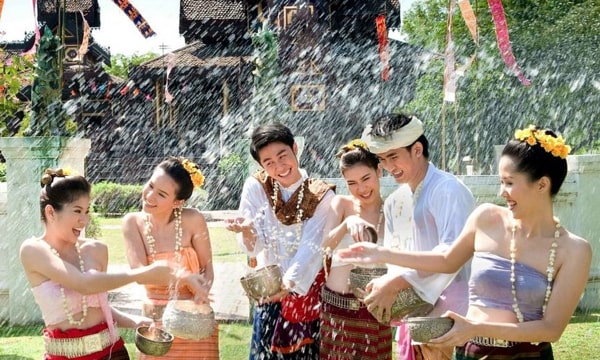
Boun Pi Mai water festival – Laotian New Year
More than just a celebration, Boun Pi Mai is an ode to life, offering residents and visitors a privileged opportunity to immerse themselves in the cultural riches of Laos.
It is also a precious opportunity to support and promote national arts, thus contributing to preserving the unique cultural identity of this land steeped in tradition.
Origin of the Laotian New Year
Given that Laos is a country where Buddhism is the dominant religion, the Laotian New Year is also calculated according to the Buddhist calendar. Boun Pi Mai is not only an occasion to celebrate the New Year but also an opportunity for the inhabitants to show their respect and gratitude towards all living creatures.
The origin of the New Year in Laos begins with an intellectual challenge between Thammabane, a clever farmer who knows the language of birds, and Kabinlaphom, the sky god considered wisest by the Laotians.
Kabinlaphom wants to test Thammabane’s intelligence by asking him three difficult questions. Although Thammabane fails to find the answers, by listening to the conversation between two eagles while he dozes under a tree, he discovers the answers to the questions.
Consequently, Kabinlaphom is forced to keep his promise and behead himself. Before his death, he instructs his seven daughters, representing the seven days of the week, to ensure that his head is treated with care to avoid harm to humans.
Thus, every year, during the New Year in Laos, his seven daughters go to the sanctuary to wash their father’s head and perform bathing rituals to pray for a new year of health and happiness.
The custom of throwing buckets of water during the Laotian New Year is also influenced by the hot climate of April, the hottest month in Laos. Before splashing water, Laotians exchange wishes for happiness and prosperity.
When is the New Year Laos in 2025?
Boun Pi Mai takes place from April 13 to April 16, marking the midpoint of April according to the Gregorian calendar. Here are the dates for the New Year in Laos from 2024 to 2028:
| Year | Date | Day |
| 2024 | from April 13 to April 16 | from Saturday to Tuesday |
| 2025 | from April 13 to April 16 | from Sunday to Wednesday |
| 2026 | from April 13 to April 16 | from Monday to Thursday |
| 2027 | from April 13 to April 16 | from Tuesday to Friday |
| 2028 | from April 13 to April 16 | from Thursday to Sunday |
In 2025, the Laotian New Year – Boun Pi Mai will take place from Sunday April 13 to Wednesday April 16.
Where does Boun Pi Mai take place?
Luang Prabang and Vang Vieng stand out as the two most popular destinations among tourists during the Boun Pi Mai water festival, hosting the New Year celebration in Laos.
If you happen to visit Laos during these days, be prepared to be greeted with water jets and stay vigilant as you might end up drenched to the bone, whether you’re driving or strolling through the streets.
The trick is to blend into the lively crowd, pack enough clothes to partake in water games, and relish in one of the finest festivals of the year.
Luang Prabang
Renowned for its plethora of temples and its ancient capital still exuding the influence of European architecture, Luang Prabang offers international visitors the opportunity to immerse themselves in the festive atmosphere and Laotian cultural customs.
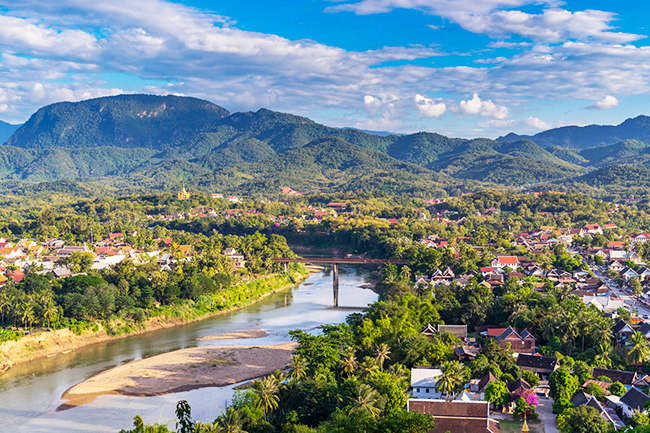
Perspective and stunning scenery in Luang Prabang, Laos
A variety of events are organized to celebrate the arrival of the new year, such as the elephant procession from Vat Mai temple to Vat Xiengthong temple, the New Year procession from Thai Noy temple to Xiengthong temple, as well as lantern parades and the Nang Sang Khan procession.
Vientiane
The capital of Laos, Vientiane, provides a peaceful and distinctive ambiance. Particularly during the New Year festivities, the city comes alive with vibrant colors adorned with characteristic floral decorations.
The Laotian New Year in Vientiane in 2025 will be an opportunity for locals to cool off from the stifling heat of 35 degrees Celsius through the water festival.
Additionally, tourists should explore popular destinations in Vientiane, such as strolling along the Mekong River, visiting the Patuxai Arch of Triumph, and Wat Sisaket, the oldest and most sacred Buddhist temple in the city.
What activities to do ? Three special days during this festival
1. First day – Start of the water festival
On the eve of the New Year (April 13, 2025), Boun Pi Mai in Laos kicks off with a flurry of activities.
Homes are meticulously cleaned, temples receive a fresh coat of paint, and a fragrant blend of saffron, souchet flowers, blooms, and aromatic herbs is prepared to create scented water.
This aromatic mixture serves a sacred purpose, as it’s used to anoint Buddha statues, Buddhist trees, and temple flowers.
The act of cleansing Buddha statues carries profound significance, believed to impart blessings to the water used, which is then ceremoniously collected by people to be poured over their family members and loved ones.
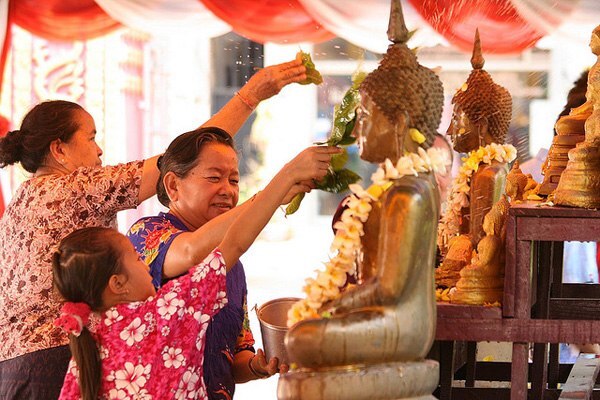
Local people clean Buddha statues during the Laotian New Year
Beyond mere symbolism, the festival unfolds in joyful celebration where participants not only joyfully splash each other with water but also bestow blessings upon their homes, sacred objects, livestock, and livelihood tools.
The act of water throwing is laden with symbolism, representing the purification of negativity, including illnesses, and the arrival of a prosperous and healthy new year. It’s believed that the more soaked a person becomes, the more luck and happiness they receive.
2. Second day – Peak of the water festival
April 14 marks the climax of the water festival, symbolizing the transition from the old year to the new amidst vibrant jubilation.
The air resonates with the beat of drums, harmonious melodies, and rhythmic steps of the traditional Lamvong dance, punctuated by the infectious laughter of the young, infusing every corner of the street with an electrifying energy that invites everyone to join in the festivities.
Preparations for the day include assembling large water cannons and balloons filled with powders, water, creams, and a range of vivid dyes, setting the stage for the main event – an exuberant water battle.
Festival participants find themselves immersed in an atmosphere of unparalleled joy and camaraderie, seamlessly mingling with the locals in what is hailed as one of the most enjoyable and inclusive celebrations in the world.
The water battle transcends barriers of age, nationality, and belief, uniting individuals in the common pursuit of blessings and rejoicing, whether they are young or old, acquaintances or strangers, indigenous or foreign. At this moment, all are united in the pursuit of jubilation and community harmony.
3. Third day – Family blessing ceremony
Laotian families gather for a traditional blessing ceremony, a poignant gesture of reverence and family unity.
Younger members tenderly pour water over their elders, expressing wishes for longevity and good health, while the elders respond with blessings and reflections on significant family events such as births or marriages.
A highlight of the day is the creation of sandcastles representing the Phoukaokailat mountain.
These structures are then abundantly doused with scented water, symbolizing wishes for prosperity, good health, and protection against malevolent spirits upon the arrival of the new year. And finally, on April 16, the sign that the Laotian New Year is officially concluded.
Other suggested activities for tourists
Experience the essence of the Laotian New Year with “Laap”: A traditional dish symbolizing good fortune made from pork, chicken, or beef and served with sticky rice. Laotians believe that consuming it brings prosperity and luck for the coming year.
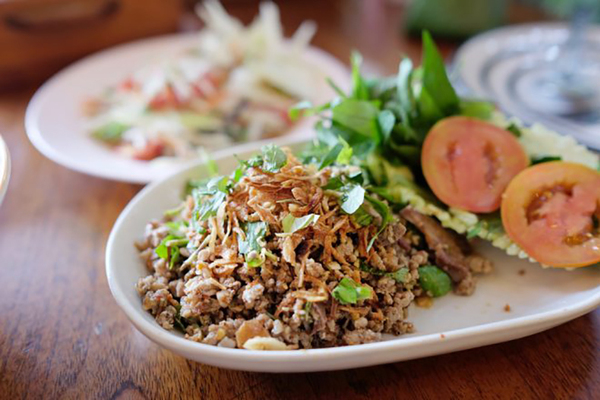
Laap – A Laotian Specialty Not to Be Missed
Wear traditional costumes from Laos: Female tourists should try wearing the “Sinh,” a silk and cotton skirt adorned with intricate patterns, paired with blouses and accessories such as the “suea pat” and the “pha biang” shawl.
Men opt for the Salong pants paired with shirts and the “pha biang” or “yao” silk shawl. Champa flowers are transformed into necklaces, symbolizing good luck, while yellow cassia flowers express wishes for prosperity.
Participate in other festivals: The festival includes offerings to Buddha with fresh flowers gathered by monks, nuns, and villagers, accompanied by traditional music.
Boat races are a highlight, with the Nang Sangkhane procession in Luang Prabang being the most renowned, featuring seven girls representing the children of the god Kabinlaphom.
Tips for tourists visiting Laos during the New Year 2025
- Boun Pi Mai marks the busiest tourist season in Laos. You should plan your trip quickly and purchase a plane ticket, book a hotel, and other services as soon as possible, at least two months in advance. Contact a travel agency; they will help you develop a travel itinerary with the best price for your Laos tour.
- Expect to get wet during the Boun Pi Mai water festival 2025, but be careful not to splash monks, the elderly, or well-dressed individuals attending New Year events in Laos.
- Laotians hold great reverence for the Buddhist faith. When visiting temples, it’s imperative to maintain order and respect. Avoid dressing immodestly or using inappropriate language or teasing. Never turn your back to Buddha statues or engage in loud chatter inside the temple. Pay close attention to the prohibition signs here.
- Pay close attention to the prohibition signs here. If photography is prohibited, you must adhere to it. Don’t attempt to capture a few souvenir shots just because you find the architecture beautiful; you’ll be promptly asked to leave if caught.
- Learn some basic wishes to say to the locals; it will have a special meaning for them in the new year. You can say “Sabaidi Pi Mai” or “Sok Di Pi Mai”, both meaning “Happy New Year.”
If you want to travel to Vietnam or tour to Indochina countries in April, don’t miss the extremely unique and typical Southeast Asian New Year celebrations in Laos, Cambodia, and Thailand!
Read more :

